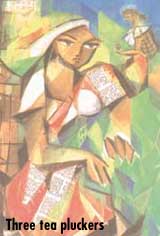 |
 22nd November 1998 |
Front Page| |
A
disruption in Segar's life resulted in fury and frustration and then artistic
creation
Angry strokes to subtle softnessAn exhibition of Segar's paintings presented by the Serendib Gallery will be held on November 25, 26 and 27 at the Lionel Wendt from 9.30 to 8.30 p.m. daily. By Ellen DissanayakeThere are probably as many paths to be- coming an artist as there are artistic styles and finding out about a particular artist's individual path can be almost as intriguing as becoming acquainted with his or her individual works.
His hand-painted cards were so popular that he got the idea to have the outline printed and get his friends and family to hand- colour them. The stimulus that made Segar into an artist came as a result of a disruption in his life. Property developers bought the land on which he lived with his young family in a comfortable and convenient small house in Colpetty. The family was forced to relocate to a housing scheme. The result, as a Hollywood scriptwriter might tell, turned out to be a striking and accomplished work. The artist called it "housing scheme". Although Segar says he was furious when he painted it, the bold geometry of the shapes and the patches of bright primary colours led up to a controlled and satisfying composition-suggesting a haphazard urban conglomerate, perhaps, but nevertheless made coherent by a natural talent for rhythmically organising colours and simple geometric forms on the two-dimensional picture surface. What initially looks like an abstract work actually contains a jumble of roofs, house fronts, windows and stairs. There is no single source of light or point of view, rather a collection of adjoining and sometime overlapping planes and coloured shapes that lead the eye backward and forward in depth. And up and down across the surface, somehow holding together even though they cannot be "read" from one fixed perspective. Reaction to this painting was so interesting, that in September 1984 he held his first one-man exhibition at the Alliance Francaise, Colombo immediately after resigning from Elephant House. Since that first exhibition less than 15 years ago, he has had at least one, one-man show every year thereafter, in addition to exhibitions in Bombay, Sydney and London. Since 1991 his works have been on permanent exhibition at the Trans-Asia Hotel. The general artistic formula of the "housing scheme"
remains but is now looser with softer, subtler colours, often resembling
patches of refracted light. Many paintings have an overall tonality - say
cool blues and yellow green - "The Three Tea Pluckers"
which appeared in the February "Reader's Digest this year, or soft
yellows and browns or almost monochromatic tans and black "Lord
Buddha", "Still Life", "Man and Wife",
rather than the raucous cacophony The planes now overlap more than adjoin providing the kind of shifting evanescence (something like a scene illuminated through wet glass that one can achieve with water colour. Yet as in "housing scheme", the reliance on variations of simple geometric shapes remaining and foliage, shadows, buildings, objects, bodies and clothing are all composed of coloured patches, with larger overall directional lines of force skilfully anchoring the variegated patches horizontally, vertically and diagonally into an agreeable whole. Segar's subjects like "Still Life" (ruins - more appropriate title) are from the Sri Lankan world about him: tea pluckers, oriental dance,the drummers, tea boutique, cricketers, raga neelambari. Such popular subjects no doubt generate their own intrinsic appeal, but their renderings in the now perfected recognizable Segar's "refracted cubistic" style are at least as much a cause of the artist's success. This vocation, incidentally, has enabled him to start building his own home in a salubrious location designed specially for him by Minnette de Silva, the Sri Lankan architect who has been associating with Pablo Picasso and Le Corbusier who architectured the city of Chandigarh. Thus leaving the housing scheme behind, again both actually and metaphorically. |
||
 |
More Plus * Trinity campus in the Pallekelle hills
Front Page| News/Comment| Editorial/Opinion| Business| Sports | Mirror Magazine |
|
 |
Please send your comments and suggestions on this web site to |
|
 In
the case of D. Raja Segar, one of the handful of Sri Lankan artists who
is able to make a living entirely from his painting, the story of how he
found his true vocation as an artist is especially interesting. Segar was
not one of those school boys who exasperated his parents by spending every
spare moment drawing, nor did he follow art as a subject in school. He
did, however, occasionally make greeting cards for his friends, especially
for the American lady who complained that the Sri Lankan cards are copied,
western-oriented and do not depict Sri Lanka life at all.
In
the case of D. Raja Segar, one of the handful of Sri Lankan artists who
is able to make a living entirely from his painting, the story of how he
found his true vocation as an artist is especially interesting. Segar was
not one of those school boys who exasperated his parents by spending every
spare moment drawing, nor did he follow art as a subject in school. He
did, however, occasionally make greeting cards for his friends, especially
for the American lady who complained that the Sri Lankan cards are copied,
western-oriented and do not depict Sri Lanka life at all. of
primary colours as in the earliest works.
of
primary colours as in the earliest works.